IDENTIFYING INNOVATIVE FOOD CHOICES
 SYSCO's customers include restaurants of all kinds, which
accounted for the bulk of sales in fiscal 1999 - 64 percent - while
hospitals and long-term healthcare facilities constituted 10 percent. In
addition, schools and colleges represented 7 percent of total sales,
while hotels and motels comprised about 5 percent.
Churches, camps, cruise lines, theme parks and other
foodservice locations combined to represent the
remaining 14 percent of sales. The heart of SYSCO's
business is to help this variety of customers create plea-surable
dining experiences based on delicious and, as
customer surveys reveal they desire, innovative food
choices that reflect today's evolving tastes.
SYSCO's customers include restaurants of all kinds, which
accounted for the bulk of sales in fiscal 1999 - 64 percent - while
hospitals and long-term healthcare facilities constituted 10 percent. In
addition, schools and colleges represented 7 percent of total sales,
while hotels and motels comprised about 5 percent.
Churches, camps, cruise lines, theme parks and other
foodservice locations combined to represent the
remaining 14 percent of sales. The heart of SYSCO's
business is to help this variety of customers create plea-surable
dining experiences based on delicious and, as
customer surveys reveal they desire, innovative food
choices that reflect today's evolving tastes.
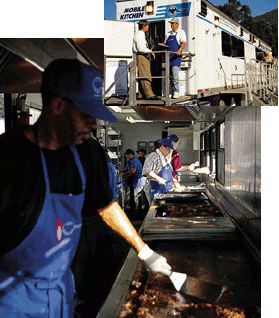 OK's Cascade Company's
mobile kitchen is a SYSCO
customer that provides
meals to forest fire fighters
from an 18-wheel tractor-trailer
customized for
buffet-style serving.
OK's Cascade Company's
mobile kitchen is a SYSCO
customer that provides
meals to forest fire fighters
from an 18-wheel tractor-trailer
customized for
buffet-style serving.
The Marketing and Merchandising Departments use
customer feedback to identify and support new dining trends that
keep diners returning time and time again for meals they love.
Company professionals work hand-in-hand with suppliers to
custom-tailor new products and test new marketing and
merchandising methods, making it possible for customers to
build a repeat clientele based on personal menu favorites.
One example of the consumer's quest for new and delectable
tastes is the surge in popularity of ethnic foods throughout
the 1990s. SYSCO was at the forefront of this trend when it
created, with its suppliers, ethnic product groupings and a line
of other specialty products to join the SYSCO brand family.
Arrezzio™, which has been the most popular, has strongly impacted the
Italian market segment. Casa Solana™ and Jade Mountain™ are its
Mexican and Asian counterparts, while the Block & Barrel™ brand,
frequently seen advertised on the rear door of SYSCO delivery trucks, is
marketed to the delicatessen segment. House Recipe™, another specialty
brand that initially was introduced as a line of tabletop sauces, appeals to
customers' desires to feature an upscale specialty brand. Featuring
individual neck bands customized with the restaurant's name, this highly
successful line now includes sugars, sweeteners, jams, jellies, dressings and
many common seasonings comparable to other national brands.
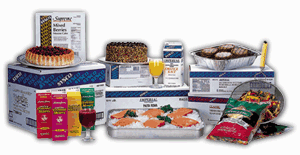 SYSCO offers a variety
of frozen products, including
fresh meats, fruits and
vegetables as well as bakery
specialties and other foods.
SYSCO offers a variety
of frozen products, including
fresh meats, fruits and
vegetables as well as bakery
specialties and other foods.
RESPONDING TO CUSTOMER CONCERNS
SYSCO recognizes that its customers are concerned about issues that
affect their businesses. In recent years, food safety issues have become
a primary concern to the public. SYSCO's commitment to food safety
is evident throughout every aspect of its business - from receiving to
warehousing, loading and delivery. Both inbound and outbound
products are received into the warehouses and loaded onto trucks
for delivery from temperature-controlled docks. Once received,
products are warehoused in areas that have multi-zoned
temperature levels appropriate for each product, then delivered
in triple-compartmented vehicles which are segregated by
temperature for frozen, refrigerated and dry items. SYSCO also
offers customers special training programs in safe food-handling
practices, such as SERVSAFE, devised by the National Restaurant
Association's Education Foundation, to help eating establishments
operate their businesses more efficiently and safely. The program offers food
safety instructions, including training in proper food storage temperatures,
safe cutting and handling techniques (to avoid cross-contamination) and
recommended hygiene practices. At the end of fiscal 1999, more than
15,000 foodservice operators across the U.S. had received training at
SYSCO-sponsored SERVSAFE® training seminars. From creating menus to
developing training materials for restaurant employees, SYSCO believes that
providing customers with the tools for success is an integral part of building
customer loyalty.
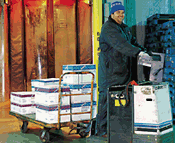 Customers expect to receive
products undamaged and at
the proper temperature, so
loading docks are refrigerated
accordingly. In the photo, Roel
Martinez leaves the freezer
with an order.
Customers expect to receive
products undamaged and at
the proper temperature, so
loading docks are refrigerated
accordingly. In the photo, Roel
Martinez leaves the freezer
with an order.
LEVERAGING WAREHOUSE TECHNOLOGY
Over the years, advances in technology have allowed SYSCO to warehouse
products more efficiently and deliver consistent quality products on a timely
basis. As a result, inventory turnover rates continue to improve and averaged
17 days of sales in fiscal 1999. SYSCO's broad range of 275,000 products are
transported by rail, roadway or air from points around the globe to its 78 distribution
centers. Each traditional foodservice facility may serve 4,000 to 7,000
customers and inventory 10,000 to 16,000 products.
 Winter sports are
popular across North
America and SYSCO has
many ski resort customers.
It is important that
products be delivered as
promised to meet the
customer's "time window,"
whether taken to the
top of the mountain by
snow caterpillars or
carried up the gondola
lift in a container.
Winter sports are
popular across North
America and SYSCO has
many ski resort customers.
It is important that
products be delivered as
promised to meet the
customer's "time window,"
whether taken to the
top of the mountain by
snow caterpillars or
carried up the gondola
lift in a container.
The SYGMA centers, which specialize in chain restaurant distribution, supply
multiple locations of one to five large restaurant customers and inventory
150 to 350 items per customer. The warehouses are divided into dry, freezer,
and cooler storage. Within the cooler, at least three optimal temperature zones
and varying humidity levels maintain products at their appropriate temperature.
Each storage area is designed to retain the quality of various types of produce,
dairy products, meats, packaged and canned products, dry goods and frozen products. One of the basic services that customers expect is to
receive products undamaged and at the proper temperature.
Refrigerated loading docks with temperatures maintained near 55
degrees keep the environment stable as pallets of product are transferred
from inbound vehicles to inventory, then loaded onto outbound SYSCO
delivery vehicles.

Number of Cases Delivered Per Week
(in millions)
|
Striving toward the objective of perfect service, SYSCO introduced
an initiative in 1999 to reduce the number of stock keeping units (SKUs),
or items, by 10 percent during fiscal 2000. Eliminating duplicate and
slower moving products will provide several benefits, including more
efficient use of warehouse space and inventory reductions.
This program is made possible with tools now available
on the SYSCO Uniform System (SUS).
SUPPORTING ITS COMMITMENT WITH
TECHNOLOGY
The commitment to error-free service is supported
by the installation of the SYSCO Uniform
System, to be completed by December 1999. This
major update of management information computer
systems has been under development for
over five years. The system is Year 2000-ready and is believed to be
the most advanced in the industry. SUS provides compatibility between
all areas throughout the company, comprising procurement, pricing,
warehousing, order processing, logistics, delivery, executive information
and billing and finance applications.
|
 |
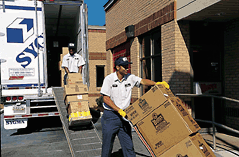
|
SYSCO's delivery associates
are "the eyes of SYSCO,"
interfacing with customers
and providing feedback
to the sales and warehouse
staff. Pictured left to right
are drivers Thomas Crump
and Kavin Griffin.
|
Measurement and reporting tools within the system enhance the
ability to monitor productivity and service levels and provide key information
to customers. To evaluate productivity improvements, reports for
individual operating companies now compare results to the average of
the best 25 percent of SYSCO operating companies - raising the bar on
key performance measures.
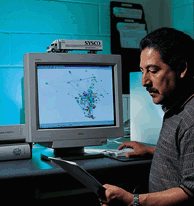 Sophisticated computer routing
systems determine the most
efficient routes and delivery
times. To increase customer
satisfaction, reports focus on
improving deliveries within
specified "time windows." In
photo: Albert Granado, Router.
Sophisticated computer routing
systems determine the most
efficient routes and delivery
times. To increase customer
satisfaction, reports focus on
improving deliveries within
specified "time windows." In
photo: Albert Granado, Router.
The first application of SUS was the warehouse
management component, the SYSCO Warehouse
Management System (SWMS). It includes two
components - inventory management and labor
management. The first encompasses a locator system
and a fully directed warehouse management system that tracks inventory
through every aspect of its life within SYSCO - from receipt to storage, selection
and delivery. Through improved order accuracy and inventory control, the
system should increase productivity and help control costs and expenses.
The labor management segment is a tool used to increase safety and pro-ductivity
and improve accuracy and efficiency by managing an employee's
production time throughout the day.
 Employees have new tools to
help them be more productive.
The finger-mounted SOS
product scanner verifies an
item's bar-coding and has
significantly reduced mispicks.
Employees have new tools to
help them be more productive.
The finger-mounted SOS
product scanner verifies an
item's bar-coding and has
significantly reduced mispicks.
A further enhancement is a new finger-mounted product scanner
that allows a warehouse product selector to verify - with the touch of a
finger to bar-coding on the package - that the correct product has been
pulled for a specific order. The scanner - called the SYSCO Order
Selector (SOS) - tested very successfully in 1999, significantly
reducing the frequency of order-selection errors. By increasing accuracy
in order fulfillment, SOS should reduce costs associated with
returning and replacing products selected in error, ultimately
enhancing customer satisfaction.